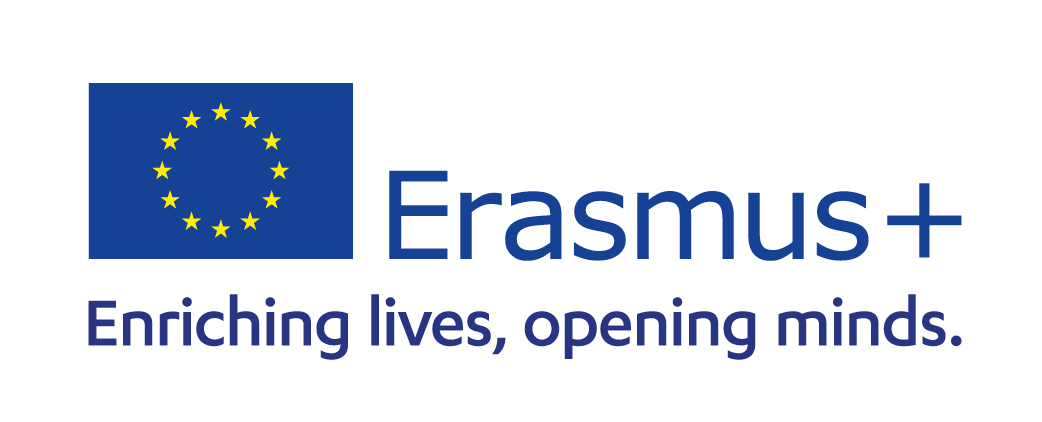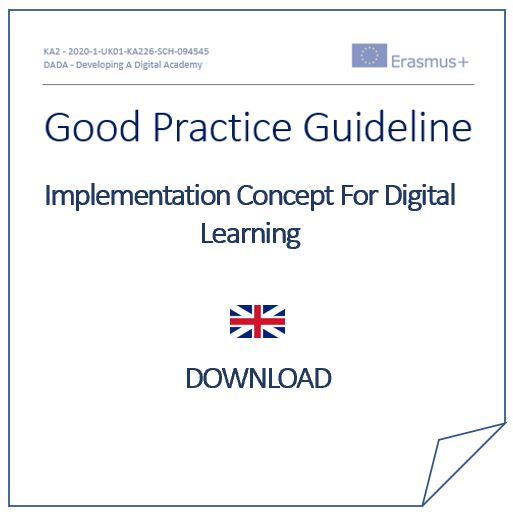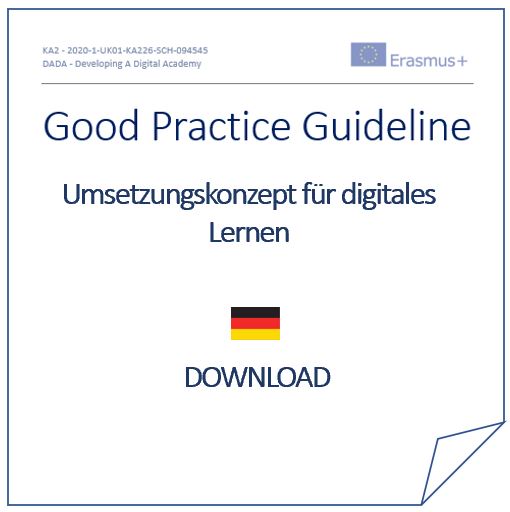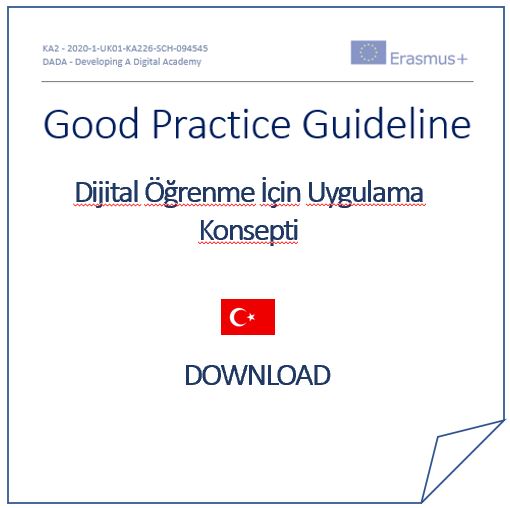DADA
DEVELOPING A DIGITAL ACADEMY
Implementation Concept For Digital Learning
Index
Why can schools benefit from a good practice guideline?
Guide to the implementation of digital education.
Lesson examples including lesson plans and learning maps.
Development of an individual implementation concept for digital education at each school
Implementation concept for digital education as an important part of school development.
Joint work on the implementation concept.
Ideal cast for the implementation concept team..
Essential components of an implementation plan.
Definition of individual goals for digital education.
Instruments for a structural approach and schedule.
Feedback: Surveys and Evaluation.
Why can schools benefit from a good practice guideline?
When considering the range of core competencies associated with the educational mandate in the field of digitization, it can be stated without a doubt that schools are confronted with a colossal task in this context. All subjects, all teachers and all areas of school organization are affected. For this reason alone, a very well organized and structured approach is required.
The partner schools and institutions in the DADA project have therefore set out to identify and lay down the characteristics of a recommended approach.
The work on an implementation concept for core competencies in the field of digital education is of great importance to use the current digitization impulse in schools effectively. It is now important to continue this impulse in the long term and to systematically incorporate the changes and experiences caused by the pandemic into media-related school development.
Guide to the implementation of digital education
The participating partner schools and educational institutions from the countries involved in the DADA project have developed essential basic elements in the course of the project, which represent a skilful approach to implementation. The basic structure of the guide is summarized below.
The guide forms the basis for systematic competence development and focuses on teaching, personnel and organizational development. Accordingly, the implementation concept is based on the building blocks media curriculum, training plan and equipment plan.
For sustainable and successful work with the digital implemantation concept, continuous revision and further development of the individual modules is recommended.
These three building blocks are derived from the general conceptual considerations for the implementation of the topic of digital competence promotion at your own school and are based on the competence framework presented below.
The core of the concept is the curriculum, in which the practical implementation of the jointly developed focal points in the field of media education and digitization is systematized and recorded.
From this concrete implementation, certain competencies can be derived that teachers should necessarily have. In addition, this results in the need for technical equipment and organizational structures for the use of digital media.
A close interlocking of the individual elements is therefore an essential criterion of a good media concept.
Lesson examples including lesson plans and learning maps
As part of the project, the partner schools created a large number of teaching examples that are intended to illustrate how a curriculum can be supplemented with valuable teaching modules in all subjects.
Download here: https://dada-project.eu
The teaching examples and teaching sequences provided by the project schools illustrate how the content of the media curriculum can be implemented by providing teaching examples. In these, it is also made clear to the teacher which media skills the students should acquire through the respective processing, which increases the obligation of a corresponding implementation.
Digital Competence Framework
An essential and fundamental component of the Guide Practice Guideline was the project’s objective with regard to digital education. The aim was to train students in basic skills in order to be able to successfully and responsibly prove themselves in a digital world. The developed competence framework for the digital world is a framework concept for the development of media competence among schoolchildren.
The competency framework comprises five areas:
- Information and data literacy: This is about understanding and handling information and data, e.g. evaluating sources, using search strategies or data security.
- Communication and cooperation skills: This area is about the ability to communicate and collaborate successfully in digital space, e.g. using social networks or working in virtual teams.
- Production of media content: This is about creating your own media content, e.g. writing texts, creating photos and videos or programming applications.
- Security competence: This area deals with the safe and responsible use of digital technologies and media, e.g. the protection of personal data or dealing with cyberbullying.
- Problem-solving skills: This is about the ability to independently solve problems when dealing with digital media and technologies, e.g. diagnosing errors in software problems or developing solutions for complex technical problems.
This competency framework for the digital world is intended to serve as a basis for the design of curricula and the development of educational offerings in the field of media competency at schools.
Development of an individual implementation concept for digital education at each school
The guidelines for implementing the digital competence framework provide for schools to develop an individual implementation concept. A uniform concept that is implemented identically cannot make sense, since the requirements at the locations are far too different. However, important planning areas are described in our guideline, which must be considered at every school and require a systematic approach. We consider it very important and profitable to conceptualize a strategic plan at every school that pursues concrete objectives and influences the curriculum design of the classes.
Such an implementation concept helps schools to systematically plan and design the use of digital media in the classroom. It's not just about the school's technical equipment, but also about teaching media skills. Pupils should learn to use digital media safely and responsibly, to evaluate and critically question information, and to produce media content independently.
The implementation concept thus contributes to the fact that pupils acquire the necessary skills and competencies for the digital world and can successfully find their way in the digital society. It also enables a didactically use of digital media and ICT in the classroom and can thus contribute to increasing learning motivation and success.
Implementation concept for digital education as an important part of school development
Digital Competence development planning is an important part of school development. The implementation concept for digital competence should therefore be anchored in the school development program. This means that digital education is mentioned as an overarching goal in the school development program, with any sub-goals and measures in the media concept corresponding to this.
The individual building blocks of the concept should be continuously adapted to current circumstances and further developed. For this purpose, a regular review of the respective measures makes sense.
Close cooperation between the concept team and those responsible for school development at your own school is therefore essential. In addition, school development moderators can offer direct help on site.
Joint work on the implementation concept
One goal of the concept is to firmly anchor digital education in the pedagogical work of the school. The conceptual work is usually done by a small team. For the successful realization and further development of the concept, however, the participation of everyone is required. This is particularly evident in the curriculum for digital learning, the implementation of which ultimately affects the teaching of every teacher. To ensure that implementation is true to the concept, there needs to be broad participation from the college right from the start.
In addition, the other members of the school family should also be included in the work on the media concept. In addition to the teachers, parents and students should also be given the opportunity to contribute and collaborate.
Ideal cast for the implementation concept team
The core of the media concept team ideally consists of:
- Members of the school board
- Teachers with experience in the field
- Media and ICT education (e.g. system administrators, coordinators for digital learning)
- School development consultant
The core composition of the team should remain constant in the medium term. In order to enable further development of the project, the team must always be open to interested colleagues who want to support the process permanently or temporarily.
Essential components of an implementation plan
The implementation concept comprises various components, which are explained in more detail below.
Definition of individual goals for digital education
The media concept defines the media-pedagogical goals pursued by the school. This involves, for example, preparing the students for the digital society, teaching media skills and promoting the pedagogical use of digital media in the classroom. The competency framework presented here by the project partners is a suggestion for such an set of objectives.
Adaptation of the school's own curricula and provision of materials
The implementation concept also describes the curricula and teaching methods that the school uses in the field of digital education. The aim here is to integrate digital media into the lesson in a didactically meaningful manner to increase the learning motivation and the learning success of the pupils. The teachers should incorporate specific projects and intentions into the class curricula in the respective subjects. It is ideal if all teachers can agree on the binding implementation of individual learning areas in the grades. This requires close consultation, intensive collaboration, and long-term planning. The adapted class curricula should be available before the start of the school year.
Adjusting the curricula through elements of digitization has the following functions as an adjusting screw between the curriculum, teaching practice, teacher professionalism, school equipment and everyday reality:
- It focuses on the competencies documented in the curriculum that students should acquire in dealing with media and ICT. It supports the teacher in the systematic structure and the binding assignment of the subject and year-specific competencies to be acquired.
- It ensures that all students achieve the interdisciplinary educational goal of comprehensive media competence.
- It enables the integration of existing internal school concepts (e.g. training for asylum seekers and refugees, inclusion, STEAM measures, didactical methodical curriculum) and the networking of school and extracurricular offers.
- It creates an orientation framework for media education at school while at the same time providing transparency and reliability for everyone.
- It enables competence development, as teachers can build on existing competences in a targeted manner.
- It facilitates lesson preparation by referring to methods and materials.
- It serves to improve the quality of teaching, as concrete information on expected competences is formulated and accompanying teaching modules are available.
The specific design of the school's own media curriculum depends on the type and size of the school and other site-specific conditions, such as the student body or the school environment. Against the background of school special features and internal definitions can be made in the school's own curriculum, prioritization of school media work, together with the binding anchoring of the associated lesson design in the individual subjects. As a school-specific specification of the curriculum, the school's own "digital curriculum" can also be adapted quickly and flexibly regarding the new requirements of the digital world.
Equipment and infrastructure
The requirements for the equipment and infrastructure of the school in the field of media education are defined in the media concept. This is about the technical equipment of the school, for example the number of computers and tablets, but also about the availability of fast internet and the security of the digital infrastructure. Here, too, long-term and structured planning makes sense, which describes the improvements and adjustments in individual sections. A binding implementation plan involving all those responsible should be set out in writing. Regular round tables, also with partners from outside the school, are indispensable since the question of financing must also be taken into account when equipping the facilities.
Improving the technical basis for teaching and learning with digital media
The aim of the equipment plan is also to check to what extent the media equipment, organization, maintenance and use of space in the school already meets the pedagogical requirements, where there are opportunities for optimization of use in relation to the set goals and work priorities and where, for example, replacement or new acquisitions are necessary. The starting point is always the existing IT equipment and its current use.
Quality criteria of the equipment plan
A well-founded equipment plan…
- is based on the requirements of the “digital curriculum”,
- is based on the currently available IT equipment and examines optimization options,
- includes necessary new purchases,
- takes into account the recommendations of the experts,
- integrates the material expense bearer into the planning,
- implements various organizational concepts,
- creates a clear distribution of responsibilities in the school,
- takes into account new learning space concepts and their requirements, if necessary,
- documents the further expansion steps,
- uses support offers and contact persons for the creation or further development.
Teacher training and support
The teacher and student training offers and support offers for teachers and pupils are also described in the implementation concept. The aim here is to strengthen skills in dealing with digital media and to promote media education in schools. These offers are to be set up through in-house training offers and offers from the local support systems. Such implementation planning must also be carried out in advance of the school year in cooperation with the school and the local authority. It is advisable to form a separate steering group for this aspect in the school staff.
Recognizing training needs of the teachers
A central goal of further training planning is to systematically record these needs and document them in a transparent manner. This is essential for a planned, needs-oriented, long-term expansion of digital skills in the college.
Providing an overview of ICT-related and media-related training courses
Based on the training needs of teachers, each school determines its overall training needs and draws up a training plan. This is continuously adapted to changing needs.
Through the comprehensive documentation, the training plan gives teachers an up-to-date overview of the topics on offer and thus supports them in planning their own training courses.
Quality criteria of further training planning
Sustainable training planning...
- assumes the competencies and technical requirements necessary to implement the media curriculum,
- is based on the needs of the college and takes into account different target groups,
- covers different topics,
- systematically documents the further training offers and thus gives teachers an overview,
- takes school and subject-specific features into account,
- includes both short-term and long-term measures,
- uses the expertise available in the college for mutual collegial training,
- integrates various offers of teacher training and uses extracurricular providers,
- uses support offers and contact persons for the creation or further development
Concept development
The “digital concept” describes the measures for the development and implementation of a school's own concept. The aim here is to develop a concept that is tailored to the specific needs of the school and enables a meaningful integration of digital media into the classroom.
From our point of view, these components are essential to ensure a systematic and sustainable implementation of media education in schools and to provide the students with the necessary skills for the digital world.
SMART objectives
- Specific/concrete: Which concept is the central concept of the goal? Is the term clearly defined for everyone? What exactly would change? Is the goal in the present tense as if you have already achieved it?
- Measurable: How can those involved recognize that they have achieved their goal? From what defined state is the goal achieved?
- Attractive: Is the goal formulated positively? Can everyone involved see the benefits?
- Realizable: What resources are needed to achieve the goal? Are all resources available when needed? How did you align the goal with the other goals (no conflict of goals)?
- Time-bound: By what date should the goal be achieved?
Finally, there is always detailed planning of the individual work steps for the implementation of the various measures. The specific design of the individual measures depends on the type and size of the school and other requirements. For example, the pronounced heterogeneity in the learning requirements of pupils at special schools requires greater individualization of the curriculum and the consideration of different support needs for the realization of digital education.
Especially when planning and implementing larger projects, the tools of a structure and schedule plan known from project management can prove to be useful.
Instruments for a structural approach and schedule
- definition of the individual steps,
- Scheduling of (partial) measures,
- establishing milestones,
- assignment of responsible persons,
- distribution of (financial) resources,
- assessment of risks.
Feedback: Surveys and Evaluation
Like every development focus of a school, the implementation and updating of the implementation concept for digital education should also be embedded in an evaluation. Only by means of an evaluation can it be reliably checked whether the measures implemented so far (e.g. the internal school further training planning or the equipment plan) are suitable for achieving the self-imposed quality goals. Ultimately, however, sustainability is not achieved through the evaluation itself, but through the conclusions drawn from its results.
During the evaluation, the indicators defined for the achievement of the goals are checked with regard to their degree of fulfillment at the targeted point in time. In the case of media education, the evaluation should provide data that show the change in teaching quality or the increase in competence and knowledge of students and teachers with regard to media education. Depending on the result of the evaluation, the measures are pursued further or corrected if the goal has not yet been fully achieved.
In principle, the same instruments that are used in the context of normal quality development can be used to ensure the quality of school work to develop digital core competencies:
Internal evaluation
Some schools already have extensive quality control tools that they use as part of internal evaluation. As a rule, these record selected sections of school reality and, if necessary, contrast them with the target state.
Insofar as they are not already explicitly included and can be used as a basis for analysis, the aspects of media education at school can be added to the existing surveys.
Individual Feedback
Another feedback system is feedback that the teachers collect from their students or colleagues, for example after sitting in on a lesson.
Shadowing and the associated individual feedback can also be carried out by members of the media concept group.
External evaluation
In the external evaluation, the school is also specifically evaluated and advised by experts who do not work in the school sector. Here, the expertise of professionals is used who are not active in school but are active in the field of business and society. In the newly drafted concepts of external evaluation for schools, digital education is one of the compulsory elective topics.
The role of digital media in school management, professional cooperation and communication with parents is considered. In addition, the learning-promoting use of digital media in the classroom as well as media-pedagogical aspects are evaluated..




